
Florida Street is a popular shopping street in Downtown Buenos Aires, Argentina. A pedestrian street since 1971, some stretches have been pedestrianized since 1913.

Recoleta is a barrio or neighborhood of Buenos Aires, Argentina, located in the northern part of the city, by the Río de la Plata. The area is perhaps best known to be the home of the distinguished Recoleta Cemetery. It is a traditional upper-class and conservative neighborhood with some of the priciest real estate in the city, known for Paris-style townhouses, lavish former palaces and posh boutiques.
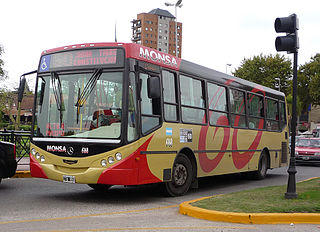
The Colectivo 60 commenced operations in 1931 and runs from Constitución station, in the centre of the city of Buenos Aires, Argentina to the Tigre Club in the partido of Tigre. The service is operated by Transportes Larrazabal C.I.S.A, DOTA and MOTSA and the identifying colour of the buses is white and red with black details.

Retiro is a barrio or neighborhood in Buenos Aires, Argentina. Located in the northeast end of the city, Retiro is bordered on the south by the Puerto Madero and San Nicolás, and on the west by the Recoleta.

May Avenue is an avenue in Buenos Aires, capital of Argentina. It connects the Plaza de Mayo with Congressional Plaza, and extends 1.5 km (0.93 mi) in a west–east direction before merging into Rivadavia Avenue.

According to the World Travel & Tourism Council (WTTC) the travel and tourism sector of Argentina was moving towards recovering its pre-covid pandemic contribution to GDP in mid-2023, led by Buenos Aires.

Barrio Norte is the informal name given to a part of Buenos Aires centering on Santa Fe Avenue and the district of Recoleta.

The Alvear Palace Hotel is a luxury hotel in Avenida Alvear in Recoleta, an upscale neighbourhood in Buenos Aires, Argentina. It opened in 1932 and, after extensive refurbishment, reopened in 1994.
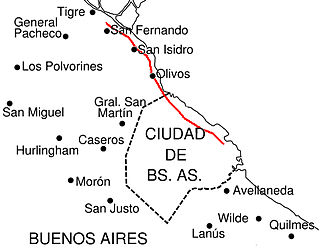
Avenida del Libertador is one of the principal thoroughfares in Buenos Aires, Argentina, and in points north, extending 25 km (16 mi) from the Retiro District of Buenos Aires to the northern suburb of San Fernando.

Avenida Santa Fe is one of the principal thoroughfares in Buenos Aires, Argentina. The artery is essential to the imaginary axis of Barrio Norte in Buenos Aires, comprising the areas influenced by the route of the avenue through Retiro, Recoleta and Palermo neighborhoods, it is considered one of the main shopping and strolling areas of the city, its many boutiques range from elegant to edgy, which has led it to be dubbed the 'Avenue of Fashion'. Upscale Alto Palermo, at Avenida Coronel Díaz, is one of the city's best-known vertical malls. Avenida Santa Fe is also an attraction for its architecture, strongly reminiscent of Paris. Its name pays homage to the eponymous province in Argentina.

Avenida Figueroa Alcorta is a major thoroughfare in Buenos Aires, Argentina, with a length of over 7 km (4.3 mi) along the city's northside.

Córdoba Avenue is one of the principal thoroughfares in Buenos Aires, Argentina.

Callao Avenue is one of the principal thoroughfares in Buenos Aires, Argentina.

The Palacio Duhau - Park Hyatt Buenos Aires is a five star hotel located in the city's Recoleta section. Originally opened in 1934, the palace has been operated by multinational hospitality company Hyatt since 2006. The palace was declared national historic landmark in 2002.
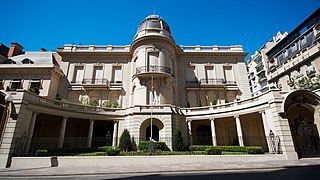
The Fernández Anchorena Palace is an architecturally significant former residence in the Recoleta section of Buenos Aires, Argentina. Today, it serves as the Apostolic Nunciature in Argentina.
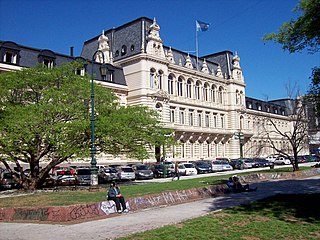
The Sarmiento Palace, commonly known as the Pizzurno Palace, is an architectural landmark in the Recoleta section of Buenos Aires and the location of the Argentine Ministry of Education.

Avenida Leandro N. Alem is one of the principal thoroughfares in Buenos Aires, Argentina, and a commercial nerve center of the city's San Nicolás and Retiro districts. It joins Avenida del Libertador and Avenida Paseo Colón, its northern and southern continuation respectively.

The Monumento ecuestre a Carlos María de Alvear located on Plaza Julio de Caro, a landmark in the Recoleta neighbourhood of Buenos Aires, Argentina, and was raised in honor of Carlos María de Alvear (1788-1852).
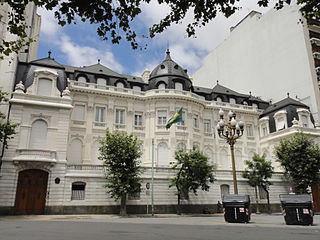
The Pereda Palace is an old manor located in front of the Plazoleta Carlos Pellegrini, at the beginning of Avenida Alvear, in Buenos Aires, at number 1130 Arroyo St. It was built by the doctor and large farmer Celedonio Tomás Pereda (1860–1941) and his wife María Justina Girado (1865–1942), member of a family of landowners as she was the granddaughter of Juan Elías Girado (1794–1858), owner of the ″Estancia San Juan″. The building is currently the residence of the Ambassador of Brazil in Buenos Aires and headquarters of the Cultural Space of the Embassy.

Recoleta railway station was a railway station in the Recoleta district of Buenos Aires, Argentina. It was opened and operated by the Buenos Aires Northern Railway since 1862, as part of the Central Station – Belgrano R line. The railway would later extend to Tigre.
























